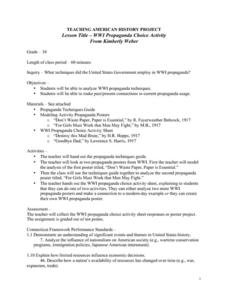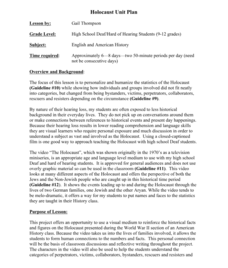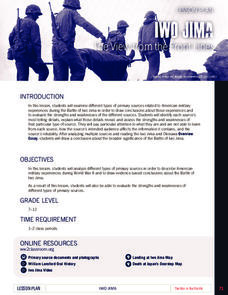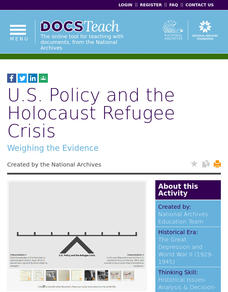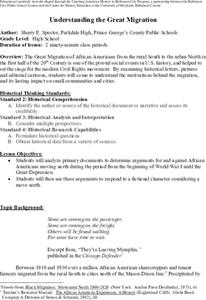Curated OER
WWI Propaganda Choice Activity
World War I propaganda techniques employed by the United States government are the focus of this lesson plan. The resource includes an excellent handout of propaganda techniques, ranging from appealing to authority to repetition, lying,...
American Battle Monuments Commission
The Battle of Pointe Du Hoc
From June 6 to June 8, 1944, the United States Army Ranger Assault Group scaled cliffs that were previously thought to be insurmountable. Learn more about a pivotal moment that led to one of the most significant battles in World War II.
Facing History and Ourselves
Do You Take the Oath?
Why did so many go along with Nazi policies during World War II? An investigatory unit includes four handouts, reading analyses, classroom discussion topics, and intriguing philosophical questions, helping learners understand the...
Facing History and Ourselves
Laws and the National Community
When it comes to the law, is justice always served? Teach scholars about how law sometimes enables prejudice of entire groups of people with a unit on World War II that includes a warm-up activity, analysis of primary sources,...
PBS
Family History: Treasure Troves
It's time for show and tell! Scholars investigate historical artifacts to determine what secrets they reveal about the time periods they represent. They then research their own personal artifacts, as well as those from World War I.
Western Illinois University
Holocaust Unit Plan
Would it have been you? Scholars investigate the horrors of the Holocaust during World War II. They view, interpret, and analyze the video The Holocaust to gain insight into who exactly was impacted by the events Europe. They then...
National WWII Museum
Evaluating the US Decision to Drop the Atomic Bombs
While the use of the atomic bomb was the definitive end of World War II, the terrible weapons left new questions. Young scholars use primary sources and analytical worksheets to consider the implications of the fateful decision. Then,...
National WWII Museum
Iwo Jima: The View from the Front Lines
Iwo Jima was the site of some of the most grim fighting in World War II. Learners consider this fact while examining primary sources, including letters home, from those on the front lines. After they complete the analysis, scholars then...
National WWII Museum
On Leave in Paris: Maps as Primary Sources
Primary sources—even those that seem mundane—offer a window into those who experienced history. Using a Red Cross map offered to soldiers stationed in Paris after World War II alongside worksheet questions, scholars consider what life...
National WWII Museum
Rationing by the Numbers: Quantitative Data as Evidence
What was it like to live on wartime rations in the United States during World War II? Young historians find out by exploring how those on the home front bought food thanks to the ration system. Other data includes statistics on car sales...
DocsTeach
U.S. Policy and the Holocaust Refugee Crisis
How did the United States respond to the Holocaust refugee crisis during World War II? The activity focuses on the United States' foreign policies and the arguments for and against offering assistance. Scholars analyze historical...
US House of Representatives
From Exclusion to Inclusion, 1941–1992
The legacy of Japanese American internment impacted America for decades, including Congress. Class members consider the tenure of Asian American representatives in Congress and how the legacy of World War II affected their service. Other...
Center for History Education
Understanding the Great Migration
What would make someone leave home and travel thousands of miles to find another one? Young historians look at letters, demographic data, and artwork to answer the question for the Great Migration, or the movement of thousands of African...
American Institute of Physics
African Americans and the Manhattan Project
A lesson about the Manhattan Project will explode young physicists' understanding of the racial attitudes in the United States during and after World war II. Groups select an African American scientist or technician that worked on the...
Penguin Books
Teacher’s Guide: The Diary of a Young Girl The Definitive Edition By Anne Frank
A line from Anne Frank's diary reads, "What is done cannot be undone, but one can prevent it happening again." Indeed, that is the hope for scholars who study her diary. The 19-page guide to the Definitive Edition of The Diary of a Young...
Curated OER
World War II Notes
In this World War II study guide worksheet, students read the notes provided regarding U.S. involvement in the war and add notes of their own.
Curated OER
End of World War One Word Search
In this world history activity, students complete a word search puzzle in which they located 14 words associated with World War I. They find words such as Germany, France, Britain, and Clemenceau.
Curated OER
Events of World War II
Ninth graders examine the main leaders and events of World War II. In small groups they analyze images of main events in WWII, listen to a lecture, and complete a fill-in-the-blank worksheet.
Curated OER
Primary History: Children of World War 2: Growing Up In Wartime
In this history worksheet, students first use the Internet to research and compare schools during World War 2 with those today. Students write a Christmas list of presents for a wartime child in the 1940s.
Curated OER
World War One Weapons- Word Search
In this word search learning exercise, students study 14 words in a word bank that pertain to weapons used in World War I. Students find the words in a word search.
Curated OER
The Blitz: World War II
In this World War II worksheet, students read about Hitler's invasion of Britain. The worksheet includes a link to additional World War II activities.
Curated OER
World War I
In this World War I worksheet, students read articles about the war abroad and on the home front. Students then respond to 20 short answer questions.
Curated OER
World War II Worksheets
In this World War II learning exercise, students read articles about the war abroad and on the home front. Students then respond to 21 short answer questions regarding the articles.
Curated OER
Evaluate Causes of U.S. Involvement in World War II
Students examine and evaluate causes of U.S. involvement in World War II by interpreting a telegram from General Douglas MacArthur to William Allen White, the publisher and editor of Kansas' Emporia Gazette.
Other popular searches
- World War Ii
- World War I
- World War I and Ii
- World War 1
- World War 2
- Causes of World War I
- Causes World War Ii
- World War One
- World War Ii Map
- World War Ii Holocaust
- World War Two
- World War Ii Battles


